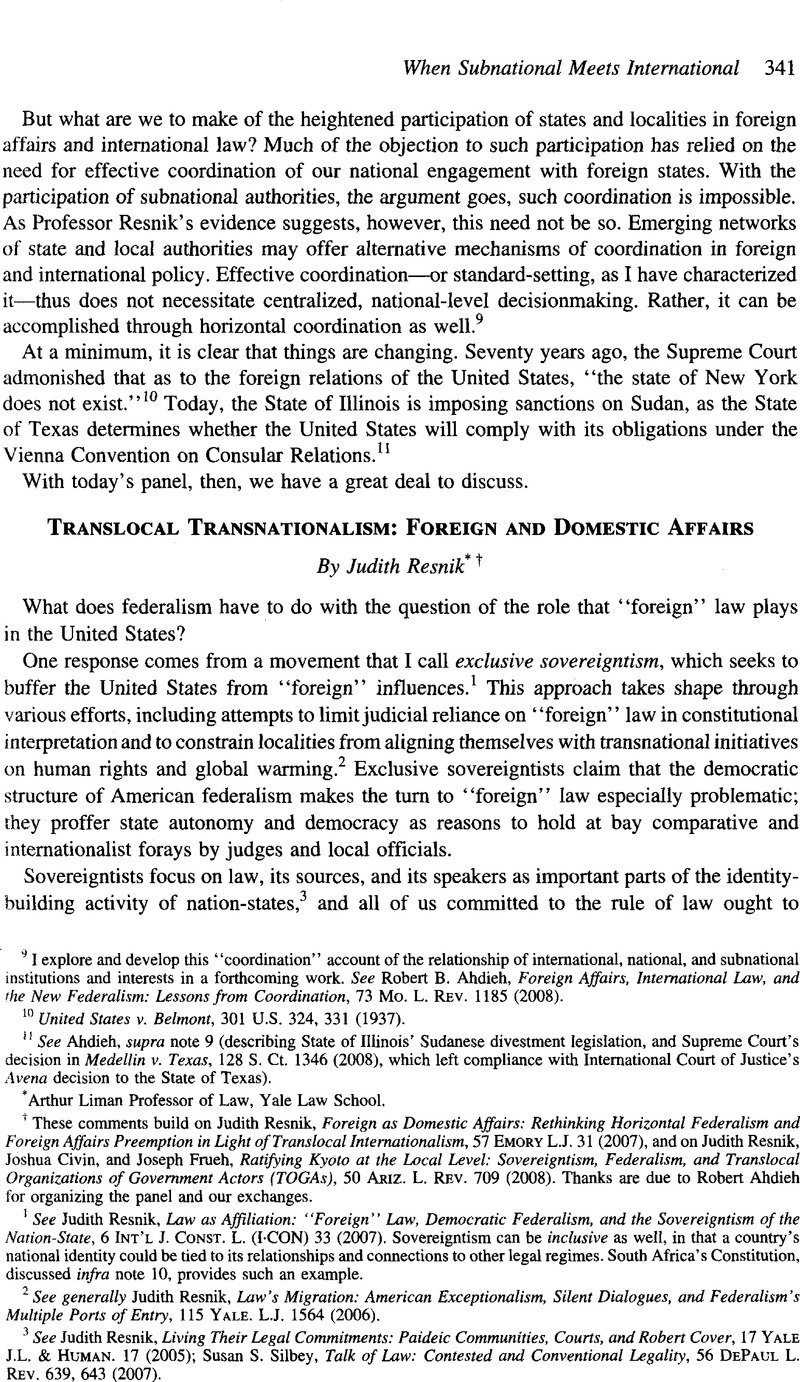No CrossRef data available.
Article contents
Translocal Transnationalism: Foreign and Domestic Affairs
Published online by Cambridge University Press: 28 February 2017
Abstract

- Type
- When Subnational Meets International: The Politics and Place of Cities, States, and Provinces in the World
- Information
- Copyright
- Copyright © American Society of International Law 2008
References
1 See Resnik, Judith, Law as Affiliation: “Foreign “ Law, Democratic Federalism, and the Sovereigntism of the Nation-State, 6 Int’L J. Const. L. (I.CON) 33 (2007)Google Scholar. Sovereigntism can be inclusive as well, in that a country’s national identity could be tied to its relationships and connections to other legal regimes. South Africa’s Constitution, discussed infra note 10, provides such an example.
2 See generally Resnik, Judith, Law’s Migration: American Exceptionalism, Silent Dialogues, and Federalism’s Multiple Ports of Entry, 115 Yale. L. J. 1564 (2006)CrossRefGoogle Scholar.
3 See Resnik, Judith, Living Their Legal Commitments: Paideic Communities, Courts, and Robert Cover, 17 Yale J.L. & Human. 17 (2005)Google Scholar; Silbey, Susan S. Talk of Law: Contested and Conventional Legality, 56 Depaul L. Rev. 639, 643 (2007)Google Scholar.
4 Convention on the Elimination of All Forms of Discrimination Against Women, Dec. 18, 1979, 1249 U.N.T.S. 13 (entered into force Sept. 3, 1981).
5 Kyoto Protocol to the United Nations Framework Convention on Climate Change, Dec. 10, 1997, 37 I.L.M. 22, available at <http://unfccc.int/essential_background/kyoto_protocol/items/1678.php.>
6 See Sassen, Saskia, Globalization or Denationalization?, 10 Rev. Int’l Pol. Econ. 1, 6, 14-15 (2003)Google Scholar.
7 See, e.g., Bolleyer, Nicole, Federal Dynamics in Canada, the United States, and Switzerland: How Substates’ Internal Organizations Affect Intergovernmental Relations, 36 Publius: J. Federalism 471 (2006)CrossRefGoogle Scholar; Betsill, Michele M. & Bulkeley, Harriet, Cities and the Multilevel Governance of Global Climate Change, 12 Global Governance 141 (2006)Google Scholar.
8 See generally Metzger, Gillian E. Congress, Article IV, and Interstate Relations, 120 Harv. L. Rev. 1468 (2007)Google Scholar. The term horizontal federalism is used sometimes to capture states’ interactions and cooperation and other times to describe discord and competition. on the interaction at the agency level, see Ahdieh, Robert B. Dialectical Regulation 38 Conn. L. Rev. 863 (2006)Google Scholar.
9 See Wechsler, Herbert, The Political Safeguards of Federalism: The Role of the States in the Composition and Selection of the National Government, 54 Colum. L. Rev. 543 (1954)CrossRefGoogle Scholar; Baker, Lynn A. Putting the Safeguards Back into the Political Safeguards of Federalism, 46 Vill. L. Rev. 951 (2001)Google Scholar.
10 Inclusive sovereigntism—insisting that one’s national identity is predicated on exchanges from abroad—is an option, as South Africa’s Constitution exemplifies. See S. Afr. Const. 1996, pmbl. & ch. 2, § 39 (describing South Africa as a participant in the “family of nations” and directing its jurists that, when interpreting that nation’s bill of rights, they “must consider” international law and may consider comparative provisions).


